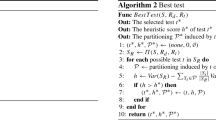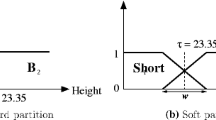Abstract
Regression via classification (RvC) is a method in which a regression problem is converted into a classification problem. A discretization process is used to covert continuous target value to classes. The discretized data can be used with classifiers as a classification problem. In this paper, we use a discretization method, Extreme Randomized Discretization, in which bin boundaries are created randomly to create ensembles. We present an ensemble method for RvC problems. We show theoretically for a set of problems that if the number of bins is three, the proposed ensembles for RvC perform better than RvC with the equal-width discretization method. We use these results to show that infinite-sized ensembles, consisting of finite-sized decision trees, created by a pure randomized method (split points are created randomly), are not consistent. We also theoretically show, using a set of regression problems, that the performance of these ensembles is dependent on the size of member decision trees.






Similar content being viewed by others
References
Ahmad A (2010) Data transformation for decision tree ensembles, Ph.D. thesis, School of Computer Science, University of Manchester, Manchester
Bartlett PL, Traskin M (2007) Adaboost is consistent. J Mach Learn Res 8:2347–2368
Biau G (2010) Analysis of a random forests model, Technical report, Universit Paris
Gerard Biau, Luc Devroye (2008) Consistency of random forests and other averaging classifiers. J Mach Learning Res 9:2015–2033
Bishop CM (2008) Pattern recognition and machine learning. Springer-Verlag, New York
Breiman L (1996) Bagging predictors. Mach Learn 24(2):123–140
Breiman L (2000) Some infinite theory for predictor ensembles. Technical Report 577, Statistics Department, University of California, Berkeley
Breiman L (2001) Random forests. Mach Learn 45(1):5–32
Dietterich TG (1998) Approximate statistical tests for comparing supervised classification learning algorithms. Neural Comput 10:1895–1923
Dietterich TG (2000) Ensemble methods in machine learning. Proc Conf Multiple Classifier Syst 1857:1–15
Dougherty J, Kahavi R, Sahami M (1995) Supervised and unsupervised discretization of continuous features. In: Proceedings of the twelth international conference on machine learning, California
Fan W, McCloskey J, Yu PS (2006) A general framework for accurate and fast regression by data summarization in random decision trees. In: Proceedings of the 12th ACM SIGKDD international conference on Knowledge discovery and data mining, pp 136–146
Fan W, Wang H, Yu PS, Ma S (2003) Is random model better? on its accuracy and efficiency. In: Proceedings of third IEEE international conference on data mining (ICDM2003), pp 51–58
Freund Y, Schapire RE (1997) A decision-theoretic generalization of on-line learning and an application to boosting. J Comput Syst Sci 55(1):119–139
Fumera G, Roli F, Serrau A (2008) A theoretical analysis of bagging as a linear combination of classifiers. IEEE Transact Pattern Anal Mach Intell 30(7):1293–1299
Geurts P, Ernst D, Wehenkel L (2006) Extremely randomized trees. Mach Learn 63(1):3–42
Gyorfi L, Lugosi G, Devroye L (1996) A probabilistic theory of pattern recognition, Springer, Berlin
Hansen LK, Salamon P (1990) Neural network ensembles. IEEE Transact Pattern Anal Mach Intell 12(10):993–1001
Ho TK (1998) The Random subspace method for constructing decision forests. IEEE Transact Pattern Anal Mach Intell 20(8):832–844
Indurkhya N, Weiss SM (2001) Solving regression problems with rule-based ensemble classifiers, ACM international conference knowledge discovery and data mining (KDD01), pp 287–292
Kuncheva LI (2004) Combining pattern classifiers: methods and algorithms. Wiley-Interscience, Hoboken
Lin Y, Jeon y (2006) Random forests and adaptive Neighbors. J Am Stat Assoc474 (101): 578–590
Mitchell TM (1997) Machine learning. McGraw-Hill, New York
Torgo L, Gama J (1996) Regression by classification. Advances in Artificial Intelligence, pp 51–60
Torgo L, Gama J (1997) Regression using classification algorithms. Intell Data Anal 4(1):275–292
Torgo L, Gama J (1997) Search-based Class Discretization, Proceedings of the 9th European Conference on Machine Learning, pp 266–273
Tumer K, Ghosh J (1996) Correlation and error reduction in ensemble classifiers. Connect Sci 8(3):385–404
Witten IH, Frank E (2005) Data mining: practical machine learning tools and techniques, 2nd edn. Morgan Kaufmann, San Francisco
Author information
Authors and Affiliations
Corresponding author
Rights and permissions
About this article
Cite this article
Ahmad, A., Halawani, S.M. & Albidewi, I.A. Consistency of randomized and finite sized decision tree ensembles. Pattern Anal Applic 17, 97–104 (2014). https://doi.org/10.1007/s10044-011-0260-8
Received:
Accepted:
Published:
Issue Date:
DOI: https://doi.org/10.1007/s10044-011-0260-8




